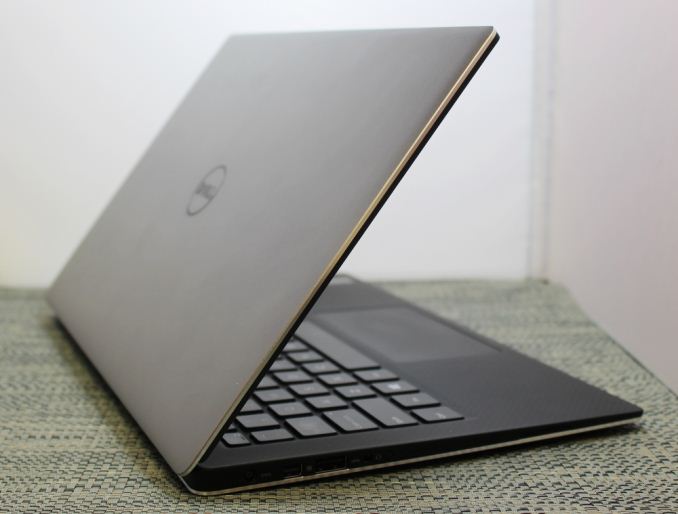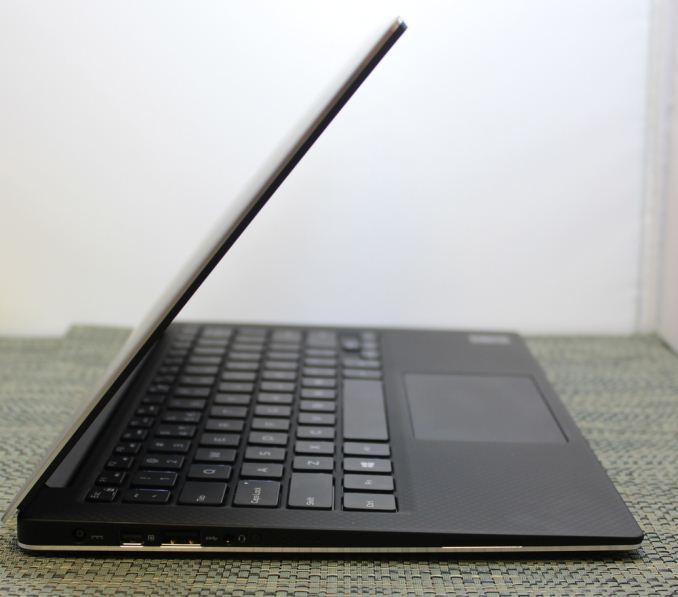Dell XPS 13 Review
by Brett Howse on February 19, 2015 9:00 AM EST- Posted in
- Laptops
- Dell
- Ultrabook
- Broadwell-U
- XPS 13
Final Words
The XPS 13 is a bold move from Dell. High quality build materials, a good keyboard, a good trackpad, and the latest generation Intel Ultrabook processor all inside a chassis with a display that is two sizes too big stuffed into it. Combine that with a 1920x1080 IPS display on the base model, as well as solid state storage as the only option, and you would expect the starting price to be north of $1000. But it is not. The base price, with a Core i3, is just under $800.
The XPS 13 also carries with it amazing battery life, especially on the lower resolution base model. Broadwell-U is part of that, but the display is also a big part of that score, especially on the light battery life test, and Dell would have had to work on the entire package to achieve this kind of battery life result. Any one choice that was a power hog would have dragged the scores down.
Of course no device is perfect and the XPS 13 certainly has some niggling issues which will hopefully be resolved in revisions or updates. The auto-brightness issue is one that they will hopefully address soon. I have no issue with auto-brightness in most cases, but there needs to a way to disable it. Not only can it be frustrating at times when the display is constantly changing brightness, especially in a dim room, but it makes display calibration impossible. If the touch version also had the Yoga style display hinge, it would also increase the capabilities of this device, although that hinge style would be wasted on the non-touch model.
The display is really the one standout feature though. Finally, someone has reduced the bezel size on a laptop. If you are not a fan of smaller laptops, this may not be for you though, since really, it is closer to a typical 11.6 inch model than a 13.3 inch. It would be unbelievable if all laptops were to follow this design pattern, but for now we can hope that at least the premium devices will do so. Dell has opened the door and shown us what is possible, and it looks awesome. The one loser in this scenario is the webcam position, which at the lower left side of the screen is far from ideal. If you are a heavy user of the webcam, this could pose an issue.
Comparing the two models is difficult. On one hand, the FHD model starts at $800 and with the Core i5, bumps up to $900. That is a great starting price for a well-built device like this one, even though the base model has just 4GB of memory. Moving to 8GB means jumping up to $1000. However the move to the excellent high resolution display is yet another $300 on top of that, bringing the least expensive model with touch in at $1300. While I do love the display, and I prefer touch on notebooks, $1300 is getting pretty expensive compared to the original price, and you lose a lot of battery life as well.
Really, it is a great choice to have to make, because neither option is the wrong one. We often lament the lack of options on other laptops, but here Dell let's users decide what they value most: resolution and display quality, or battery life. The only real issue is that you can't get touch with FHD, and you can't get 512GB SSD with the FHD either.
The Dell XPS 13 ends up being responsive, small, light, and well built. Dell has crafted what I am sure most people were hoping for when the original Ultrabook specification was announced. On top of that, they have designed a laptop with class-leading battery life, and plenty of choice to let people buy as little or as much as they need. Considering the competition, this is clearly the Ultrabook of the Broadwell-U generation to beat, and from what we saw at CES it may very well go unchallenged for the remainder of the year.












201 Comments
View All Comments
jabber - Thursday, February 19, 2015 - link
Seen quite a few cracked glass screens on touch enabled laptops. Some (including Dell) put a hole near the top of the glass for the microphone. Causes a weakspot near the top of the screen where folks will hold the screen to open it. Not very clever. Be wary of all glass screens.MonkeyPaw - Thursday, February 19, 2015 - link
I've had a glass-screened laptop for over a year (yoga 11s). My toddler pulled it off the table and onto the hardwood floor. Cracked the corner of the plastic case, but the screen is still intact.althaz - Thursday, February 19, 2015 - link
Anecdotal evidence: It's anecdotal!jabber - Friday, February 20, 2015 - link
Just something to be aware of. Anyone with knowledge of structural integrity etc. would avoid putting a hole in a brittle substance near to a point of frequent stress. It seems that laptop manufacturers aren't too clued up on this. The last one I got handed from a customer with a cracked touch screen took three visits from Dell to fix.The screens still work its just you have a nicely cracked glass layer on top. Not pretty.
superflex - Monday, February 23, 2015 - link
Trololololololololololololololololololololcknobman - Thursday, February 19, 2015 - link
Pretty solid offering from Dell.I like the i5, 8GB, 256GB, QHD+ model but the price is just too high.
The configuration that interests me is the i5, 8gb ram, 256gb ssd, FHD model which on Dells website is $1099.
Problem is I can get a Surface Pro 3 i5, 8gb ram, 256gb ssd, QHD model for $1199.
Dell needs to lower the prices on their models $100-$200.
boskone - Thursday, February 19, 2015 - link
No, they don't. The improved battery life (rougly 50-200% better) of the XPS 13 alone makes up the cost difference.It's really an apples-to-oranges comparison, though, since tablets and ultrabooks (or laptops in general) have different strengths and weaknesses.
nos024 - Thursday, February 19, 2015 - link
Add $150 to the surface pro for keyboard.mebby - Thursday, February 26, 2015 - link
Good point. Though $130 not $150.piroroadkill - Thursday, February 19, 2015 - link
Price is not too high. This is a very nice machine, and worth the money, no question.I'd have an i5, 8GiB, 256GB, FHD version. Stupid QHD+ eating FIVE hours of battery life, screw that, waste of time.
The ONLY problem with the aforementioned awesome spec is... the somewhat shitty graphics. If Intel pulls their finger out, or Dell can somehow fit better graphics in the same chassis, everyone else has been utterly schooled.